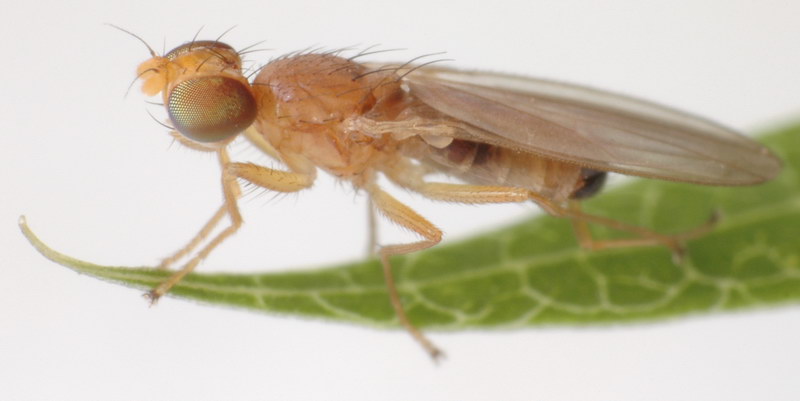Diptera.info :: Identification queries :: Diptera (adults)
|
Our town park: small Chloropidae
|
|
| Dmitry Gavryushin |
Posted on 28-06-2006 01:12
|
|
Member Location: Moscow region, Russia Posts: 3338 Joined: 17.10.05 |
June 27, 2006. Size 2-2.5mm. Dmitry Gavryushin attached the following image:  [95.75Kb] |
|
|
|
| Paul Beuk |
Posted on 28-06-2006 06:22
|
|
Super Administrator Location: Netherlands Posts: 19403 Joined: 11.05.04 |
Not Chloropidae but Chyromyidae. I think Gymnochyromyia flavella . Paul - - - - Paul Beuk on https://diptera.info |
| Dmitry Gavryushin |
Posted on 28-06-2006 07:42
|
|
Member Location: Moscow region, Russia Posts: 3338 Joined: 17.10.05 |
Thanks a lot Paul, Here's some information that I've found The family Chyromyidae is a fairly small (approximately 50 species; 1?p;5 mm in length) and little-studied group of xerophilic Diptera. Three extant and one fossil genus comprise the family, which is found worldwide except South America. Adults of extant forms have been collected on flowering plants. Immatures are virtually unknown, but adults have been reared from a variety of substrata including dung, mammal burrows, rotting wood and birds' nests (Ferrar, 1987). (http://hbs.bishopmuseum.org/fossilcat/fosschyro.html) Little is known of the life histories of the Australasian/Oceanian species. Colless & McAlpine (1970) recorded adults of Aphaniosoma spp. from flowers of Hibiscus and closely related plants in Australia, while larvae of 1 species have been collected in bat guano in caves. An undescribed species of Aphaniosoma occurs in Australia and Papua New Guinea on flowers of Santalum in dry country (D.K. McAlpine, in litt.) Adults of A. macalpinei have been collected on Scaveola frutescens and in light traps, and adults of Gymnochiromyia hawaiiensis have been collected mostly on windows as well as on Acacia and at light. Ref.: Hardy & Delfinado (1980, Hawaiian spp.). (http://hbs.bishopmuseum.org/aocat/chyromy.html) |
|
|
|
| Tony Irwin |
Posted on 01-07-2006 00:18
|
|
Member Location: Norwich, England Posts: 7318 Joined: 19.11.04 |
Mmmm.. I think this is actually Anthomyzidae. Two reclinate upper frontal orbitals, vibrissae, that spine under the fore-femur, and the pubescent third antennal segment hanging down from the second - all make it more like an anthomyzid, rather than a chiromyid. Most species of Anthomyza are grey and yellow, but A.pallida is all yellow, and I think that's the species here. Tony Tony ---------- Tony Irwin |
|
|
|
| Dmitry Gavryushin |
Posted on 01-07-2006 07:51
|
|
Member Location: Moscow region, Russia Posts: 3338 Joined: 17.10.05 |
Many thanks Tony |
|
|
|
| Jan Willem |
Posted on 01-07-2006 11:00
|
|
Member Location: Waalwijk, The Netherlands Posts: 2160 Joined: 24.07.04 |
Hi, Tricky identification after a photo with several other species looking rather similar (Anthomyza dissors, A. dorsata, A. neglecta, and A. paraneglecta). But then again, Tony may be right. Jan Willem Edited by Jan Willem on 01-07-2006 15:27 |
|
|
|
| Paul Beuk |
Posted on 01-07-2006 14:41
|
|
Super Administrator Location: Netherlands Posts: 19403 Joined: 11.05.04 |
 I concede defeat, graciously. I concede defeat, graciously.
Paul - - - - Paul Beuk on https://diptera.info |
| Dmitry Gavryushin |
Posted on 02-07-2006 20:16
|
|
Member Location: Moscow region, Russia Posts: 3338 Joined: 17.10.05 |
Today I took pictures of a very similar fly of approximately same size, collected at same location.
Dmitry Gavryushin attached the following image:  [63.33Kb] |
|
|
|
| Jan Willem |
Posted on 03-07-2006 07:22
|
|
Member Location: Waalwijk, The Netherlands Posts: 2160 Joined: 24.07.04 |
Hi Dima, This indeed looks like another Anthomyza spec of the pallida group. This is a male. Your first specimen looks like a female. For me it is too tricky to put a species name to your specimens. Jan Willem Edited by Jan Willem on 03-07-2006 08:47 |
|
|
|
| Dmitry Gavryushin |
Posted on 03-07-2006 09:43
|
|
Member Location: Moscow region, Russia Posts: 3338 Joined: 17.10.05 |
OK then, thanks Jan |
|
|
|
| Jan Willem |
Posted on 10-07-2006 09:22
|
|
Member Location: Waalwijk, The Netherlands Posts: 2160 Joined: 24.07.04 |
Hi Dima, Your second specimen (the male) has been identified as Anthomyza dissors by Dr. Jindrich Rohacek (specialist in Anthomyzidae). The female specimen might belong to the same species, but can also be Anthomyza pallida, which looks very similar. Jan Willem P.S. Dima, can you please contact me personally! |
|
|
|
| Dmitry Gavryushin |
Posted on 10-07-2006 10:59
|
|
Member Location: Moscow region, Russia Posts: 3338 Joined: 17.10.05 |
Thanks a lot again Jan |
|
|
|
| Jump to Forum: |













